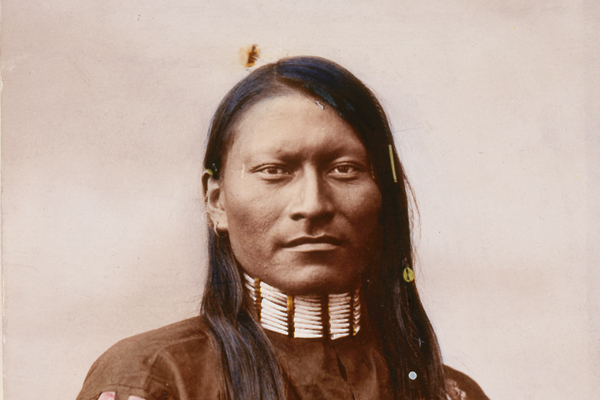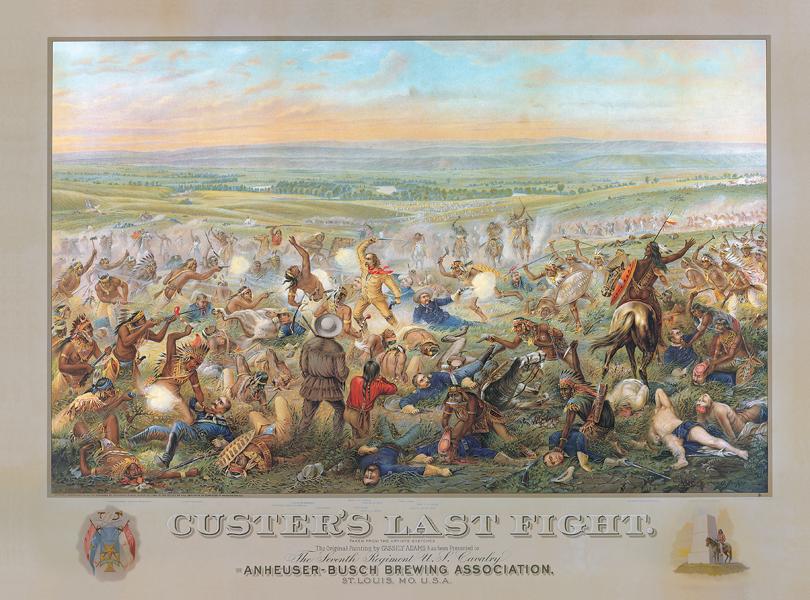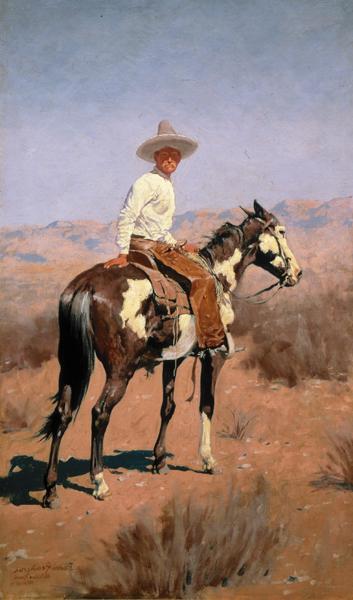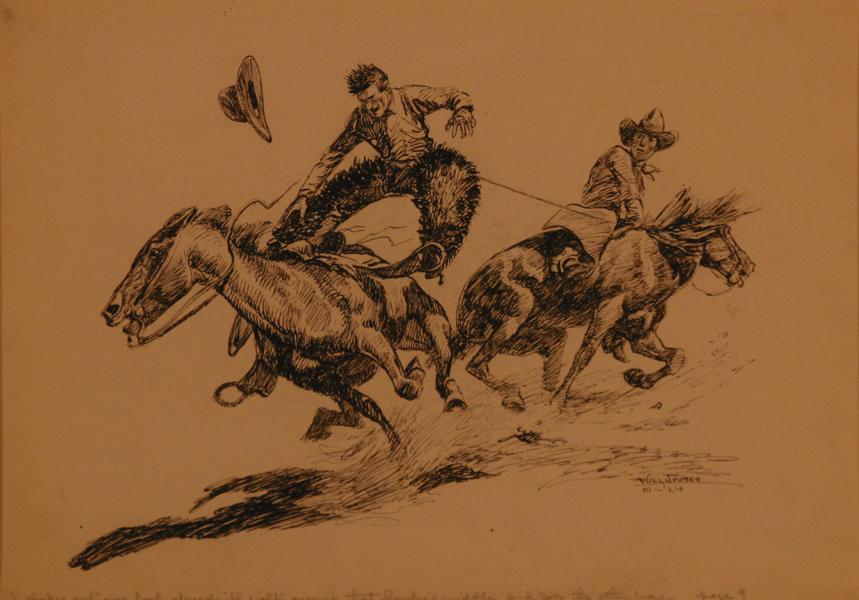 A young teen, in the 1880s, heads west to Montana to try his hand at cowboying.
A young teen, in the 1880s, heads west to Montana to try his hand at cowboying.
His passion for adventure converts him to the wilds of the Bonanza State. Before long, he trades his quirt for a paintbrush and goes on to create more than 4,000 works of art. His name is Charles M. Russell.
Another young teen, about 40 years later, spends his days surveying the north rim of Arizona’s Grand Canyon and his nights reading from the volumes on Southwest Indians published by the Smithsonian Institution. Emerging on the art scene as “Jack the Dripper,” Jackson Pollock is not the usual suspect when considering Western art icons. But his years growing up in the West did take hold of him at times, when he flailed his arms, dripping paint on his floor canvas with sticks, trowels and knives; Indian symbols would suddenly find a home amidst the energetic circles. He likened this process to Navajo sand painting.
Jackson Pollock, Albert Bierstadt, Georgia O’Keeffe, Charles M. Russell and Frederic Remington all share something else in common besides their artistic ties to the West. They have commanded some of the highest auction prices ever in the art world, and former East Coast snobs of American Western art are no longer calling the genre kitschy but world class.
Western art was once dismissed as “oil guys’ buying,” since auction houses usually saw prices rise in line with spikes in oil and cattle markets. But when oil prices fell in the early 1980s, many of these collectors were forced to sell their paintings at reduced prices and that allowed for the art to spread to a wider market. When 10-gallon hats and cowboy boots stomped into Sotheby’s auction in
New York City in 1998, the collectors collectively shelled out $25 million, buying all 44 works and setting 26 records for Western artists.
The next year, Frederic Remington made the news when his nocturne, A Reconnaissance, sold at Christie’s for a bid of nearly $5 million. Western art hasn’t lost its buzz since. ARTNews reported in 2003 that images of the Western frontier had made their way into mainstream American art. Two years later, BusinessWeek reported that the Gold Rush for Western art was still on. This year, NPR’s Weekend Edition Sunday spread the news to its listeners that American Western paintings were bringing in top dollar, preparing them for the Coeur d’Alene auction in July by sharing its record-breaking $5-million sale of a Charlie Russell painting in 2005.
Now that we know the value of Western art can match that of its East Coast peers, the only question left on our minds is, will the day ever come when they’re biting the dust left behind by our cowboys and Indians?
Editor’s Note: All prices reported in this article reflect those known by close of May 2006. Prices may have gone up since the time of publication.
ANDY WARHOL—COWBOYS & INDIANS SERIES
Warhol is known for refashioning Campbell Soup can labels and glorifying movie stars such as Marilyn Monroe, who, to this date, is the subject of the top-selling Warhol painting. The Orange Marilyn, created in 1964, sold for more than $17 million at Sotheby’s in 1998. The artist’s last series, Cowboys & Indians, created in 1986, the year before he died, is a portfolio of 10 prints including (clockwise, from top left) Wild West show shootist Annie Oakley, Apache Medicine Man Geronimo, cowboy actor John Wayne, Northwest Coast Mask, Buffalo Nickel, Plains Indian Shield, Teddy Roosevelt, Mother and Child, Kachina Dolls, Lt. Col. George Custer. The print of John Wayne (created from a publicity shot for 1962’s The Man Who Shot Liberty Valance) was recalled and the original brown of the pistol was changed to a fluorescent blue due to the threat of a lawsuit by the John Wayne Foundation. The Cowboys & Indians set was released as a limited edition of 250, but its true value cannot be assessed without a record of a public sale. Warhol’s work is so valued that an entire museum is devoted to him at one of the four Carnegie Museums in Pittsburgh, Pennsylvania (warhol.org).
PAINTING CUSTER’S DEFEAT
“No single event in United States history, or perhaps world history, has been the subject of more bad art and erroneous story than Custer’s Last Stand,” wrote Don Russell in 1969’s Custer’s List: A Checklist of Pictures Relating to the Battle of the Little Big Horn.
But despite the fact that the Indian warriors are carrying what look to be Zulu shields and that the village is shown on the wrong side of the Little Bighorn River in F. Otto Becker’s painting of the battle, his work is probably the most recognizable—it was posted as an advertisement for Anheuser-Busch in saloons and bars across the nation. Becker, though, merely created the lithograph of Cassilly Adams’ 1884 portrayal. Anheuser-Busch gifted Adams’ original painting to the Seventh Cavalry in 1895, but a fire in 1946 at Fort Bliss in Texas destroyed the painting. Today, the Custer Battlefield Museum in Garryowen, Montana, offers limited edition prints of Becker’s lithograph for $29.99 (custermuseum.org) with permission from Anheuser-Busch.
The first artist to paint a major work depicting the battle was Irishman John Mulvany. He finished his work on Custer’s Last Rally in 1881. Poet Walt Whitman praised the work as sketched “from reality, or the best that could be got of it.” To reach a mass audience, Mulvany painted a smaller version from which lithographs could be created. This copy is housed at the Woolaroc Museum in Bartlesville, Oklahoma. The 20-by-11-foot original painting is owned by Dan Francis. Interested buyers may contact him at 314-856-5278.
Thom Ross of Seattle, Washington, didn’t just paint another painting of Custer’s Last Stand, he re-created it on plywood. About 200 life-sized figures were set up on the Little Bighorn Battlefield in the summer of 2005. Ross aims for historical accuracy when portraying the West, saying, “The stoic Indian with a frown on his face … eventually become[s] a cliché … This is why the art world doesn’t take the Western art world seriously. What’s important is what happened on that day in 1876. I’m trying to set the bar higher.” Too bad Don Russell is not around to ask what he thinks about this latest batch of Custer art. What does the public think? They have shelled out up to $8,000 for one of Ross’ cutouts. He is represented by Gunnar Nordstrom Gallery in Kirkland, Washington.
MODERN COWGIRLS
Not much in the way of cowgirl art can be found among the master artists. We found one sketch by Charles Russell, titled Rodeo Cowgirl on a Bucking Bronc, but that’s about it. In terms of modern art, the cowgirl is much better represented.
From her studio in Saint Jo, Texas, Donna Howell-Sickles never tires of painting cowgirls. Her contemporary paintings of Western cowgirls have commanded up to $25,000. Shown above is her 2005 painting, which is part of a series the artist calls Soul Searching. Howell-Sickles’ work is represented by McLarry Fine Art in Santa Fe, New Mexico.
Brenda Murphy of Arlington, Texas, has received the Museum Purchase Award in 2005 for her graphite on paper, Cowgirl Woolies. It is now part of the permanent collection at Desert Caballeros Western Museum in Wickenburg, Arizona. Murphy’s work has sold for as high as $5,500. She is represented by Trailside Galleries in Jackson, Wyoming, and Scottsdale, Arizona.
MODERN COWBOYS
Sherri Belassen’s Rancher Romeo and Gary Ernest Smith’s The Cattleman are just a few examples of how the depiction of the cowboy has changed in modern times. While Remington’s painting below strives to authentically portray a vaquero, many modern examples lean toward a faceless cowboy who evokes an emotional reaction from viewers. Scottsdale, Arizona, artist Belassen has painted Rancher Romeo as an Impressionist abstract, connecting the tall, thin cowboy to a space larger than himself. Smith, who grew up on a working ranch in an isolated area of eastern Oregon, has painted a faceless cattleman, drawing viewers into his soul, and the warm orange and blue hues suggest his is surely a good soul. Smith’s work has sold for as high as $165,000, while Belassen’s work has sold for as high as $16,000. Belassen is represented by Wilde Meyer Gallery in Scottsdale, Arizona. Smith is represented by Overland Gallery of Fine Art in Scottsdale, Arizona.
FREDERIC REMINGTON—VAQUERO
Frederic Remington never once changed his subject matter—it was always the Wild West. The Virginian author Owen Wister praised Remington’s contribution to art, commenting that “Our heritage in portraiture includes the leaders of men; it does not include the men themselves. No artist until Remington has undertaken to draw so clearly the history of the people.” He certainly commands respect today. His 1902 nocturne, A Reconnaissance, depicting two figures standing at the edge of a wooded ridge with a mounted cowboy waiting behind them, sold at Christie’s New York in 1999 for a $4.7 million bid. Shown at left is his oil on canvas, Vaquero, painted at Soledad Ranch in Mexico in 1895. Since Remington hailed from New York, a museum devoted to him and his work is found in Ogdensburg (fredericremington.org). His work is also featured in New York City’s Metropolitan Museum of Art and Washington, D.C.’s Smithsonian American Art Museum, besides galleries and museums across the West.
ED MELL—JACK KNIFE COWBOY
Ed Mell’s Jack Knife so encapsulates Western bravado that the image in this painting has also been cast in bronze and the sculpture is found at the intersection of Marshall Way and Main Street in downtown Scottsdale, Arizona. Mell’s work has gone for as high as $95,000. He is represented by Overland Gallery of Fine Art in Scottsdale, Arizona.
DAVE POWELL—THE HURRICANE DECK
Dave Powell’s watercolor, The Hurricane Deck, is shown at right. Work by the Montana artist (and son of Western artist Ace Powell) has gone for as high as $5,500 at auction. His work is represented by Cowboy Legacy Gallery in Cave Creek, Arizona.
FRANK TENNEY JOHNSON—NIGHT ON THE MESA
Although Frank Tenney Johnson’s studio in Alhambra, California, was often a gathering place for artists like C.M. Russell and Norman Rockwell, Johnson hasn’t yet gotten the same recognition as his peers. Johnson’s record price at auction so far is a $350,000 bid for his 1926 oil nocturne, Journey’s End, at the 2005 Coeur d’Alene Art Auction (see “Collecting the West Roundup,” May 2006). At right is his nocturne, Night on the Mesa. Numerous galleries across the West offer works by this artist; no museum, yet, is devoted to him, but his work can be seen at the Gerald Peters Gallery in Santa Fe, New Mexico, which also released a book on this artist in 2000.
WILLIAM R. LEIGH—GATHERING PEYOTE
The Duke of Windsor and King Albert of the Belgians collected Western art by William R. Leigh, who is sometimes called the “Sagebrush Rembrandt” due to his use of traditional European techniques in his paintings of the American West. His record price at auction so far is a $365,000 bid for his 1941 painting, The Mystic. At left is his oil, Gathering Peyote, which sold in 1989 for a $12,500 bid. The Leigh studio is installed at the Gilcrease Museum in Tulsa, Oklahoma (www.gilcrease.org).
TAOS SOCIETY OF ARTISTS
Works by Oscar Edmund Berninghaus have sold for as high as $600,000. (Indians in the Snow sold last year at Altermann Galleries for a $130,000 bid.) He and other founding members of the Taos Society of Artists (which formed in 1912) are inching up to the values of works by masters such as Russell and Remington. Ernest Hennings leads them all, with his record auction price at $970,000 for Four Riders at Sotheby’s New York auction in 1998. Next in line is Joseph Henry Sharp, whose Squaw Winter sold for a $950,000 bid at Coeur d’Alene Art Auction in 2004. He’s followed by Walter Ufer, whose Sunspots sold at Sotheby’s New York for $690,000 in 1999. Then come Berninghaus and E. Irving Couse, whose 1923 painting, The Lesson, sold for $580,000 at Sotheby’s New York auction in 1998. E.L. Blumenschein’s The Red War Bonnet sold this year at the Scottsdale Art Auction for $436,800; Victor Higgins’ Pink and Black sold in 2005 at Coeur d’Alene Art Auction for $370,000; W. Herbert Dunton’s The Horse Rustler sold in 2001 at Altermann Galleries for $300,000; Bert G. Phillips’ Call of Spring (Song of Flute) sold in 1999 at Altermann Galleries for $240,000; and Kenneth Adams’ Taos Indian Evening sold in 1999 at Sotheby’s New York for $233,000.
C.M. RUSSELL—COWBOY ARTIST SELLS HIGH FOR INDIAN DEPICTIONS
Shown below is C.M. Russell’s 1919 oil on canvas, The Navajos. Last year, Coeur d’Alene Art Auction set a record for the artist when it sold his 1918 oil painting, The Piegans, for a $5 million bid (see “Collecting the West Roundup,” May 2006). Ten of Russell’s works have sold over or near the million-dollar mark at auction in recent years. His artwork is so valued that an entire museum is devoted to him in Great Falls, Montana (cmrussell.org), and his art is even featured in New York City’s Metropolitan Museum of Art.
L.A. HUFFMAN—RED ARMED PANTHER
Laton Alton Huffman is the only frontier photographer featured in this art piece. At left is his 1879 photograph of Red Armed Panther (sometimes called Red Sleeve) of Cheyenne, Wyoming, taken at Fort Keogh in Montana. He’s often viewed as the Charlie Russell of Western photography, and this photo is a telling example of why—he hand colored this print with oil highlights. The McCracken Research Library at the Buffalo Bill Historical Center in Cody, Wyoming, owns the L.A. Huffman Studio Collection. Two Rivers Gallery in Steamboat Springs, Colorado, and the Amon Carter Museum in Fort Worth, Texas, also offer fine collections of Huffman photographs. Estimates for Huffman photos at a recent auction were as high as $4,500.
MAYNARD DIXON—THE APACHE
Maynard Dixon is another master who is starting to command million-dollar prices for his artwork. In 2005, his oil, Story Tellers (Montana, October 1917), sold at Coeur d’Alene Art Auction for a $1.5 million bid. At right is his painting, The Apache, which sold in 1998 at Christie’s Los Angeles for $7,200. The Maynard Dixon Museum inside Mark Sublette’s Medicine Man Gallery in Tucson, Arizona, pays tribute to this artist (maynarddixonmuseum.com).
FEATHERED INDIANS
At far left is Fritz Scholder’s Indian with Glaucoma. Hailing from the Luiseño Mission Tribe, Scholder was one of the four founding members of the Institute of American Indian Art in Santa Fe, New Mexico. His work has sold for as high as $40,000 at auction. Upper left is Joe Beeler’s Your Enemies are Mine. Beeler was the last surviving founder of the Cowboy Artists of America. His work has sold for as high as $51,000 at auction. Scholder died last year at 67, while Beeler died this past April at 74. Gallery owners predict that work by these artists will appreciate in the near future. Work by Scholder can be seen at the Larsen Gallery in Scottsdale, Arizona. Work by Beeler can be seen at the Cowboy Artists of America Museum in Kerrville, Texas (www.cowboyartistsofamerica.com).
EDWARD BOREIN—TRAIL BOSS
Oil paintings by the California artist Edward Borein has sold for as high as a $100,000 bid in 2003. His ink/board record is quite impressive, as well, with Two Cowboys selling for $65,000 in 2005. At left is his etching, Trail Boss, which sold this year for $4,950. The Fine Arts Museums of San Francisco own numerous works by Borein (www.thinker.org).
OLAF WIEGHORST—SUMMER SHADE
Originally born in Denmark, Wieghorst eventually came to America and would visit ranches in the West. The Quarter Circle 2C brand of one ranch he worked at in the early 1920s, the Cunningham ranch near Alma, New Mexico, became his signature logo. The highest value for a Wieghorst work so far is of a pair, Navajo Madonna and Navajo Man, which reportedly sold to a private collector for $1 million. The highest auction value for a work of his is an oil painting that sold for $150,000 in 2003. Shown at right is a mixed media watercolor and pen and ink on paper illustration, Summer Shade, that has a value of $11,500. A museum is devoted to the artist in El Cajon, California (www.wieghorstmuseum.org).
WILL JAMES—ROPING A RIDER
Pen and ink illustrations sell for more than $20,000? They sure do, if they’re by a well-known illustrator like Will James. In 2005, Will James’ pen and ink on paper drawing, Cortez, sold at Brian Lebel’s Cody Old West Show & Auction for a $23,000 bid. At left is his 1924 illustration, Roping a Rider, with an estimated high value of $24,000. (Since James’ oil paintings are rarer, they lately have an estimated value of about $70,000-85,000.) No museum is devoted to the Western artist, but his original work is available from galleries such as Cowboy Legacy Gallery in Cave Creek, Arizona. Quality reproductions of his art and writings are also available from the Will James Art Company in Billings, Montana. The University of Nevada in Reno also houses the Will James Collection, donated by Anthony Amaral, author of Will James: The Gilt Edged Cowboy.
BUCKEYE BLAKE—UNTITLED
The son of a rodeo rider, Buckeye Blake took to painting the West. The Buffalo Bill Historical Center in Cody, Wyoming, exhibited his work in 1993 at the center’s first one-man show given by a living artist since 1986. His work has sold for as high as $14,250. Shown at right is an untitled oil painted in 2004, with an estimated value of $15,000. Blake is represented by Big Horn Galleries in Cody, Wyoming.
NICK EGGENHOFER—DEADWOOD STAGE
Nick Eggenhofer was known as the “King of the Pulps” for his dry brush illustrations. Late in his career, though, he settled in Wyoming and produced oils and watercolors for Western art galleries. To date, the highest price paid for his work at auction is an oil, To the Last Man, which hammered in at $39,000. Below is a gouache on board, Deadwood Stage. A gouache by Eggenhofer has sold for as high as $30,000 in 2005 for Parley on the Bozeman Trail, created in 1964. No museum is devoted solely to this artist, but his work can be found in galleries throughout the West.
Photo Gallery
Custer’s Last Rally
– Courtesy Dan Francis –
Custer’s Last Fight
– Courtesy Custer Battlefield Museum / Garryowen, Montana –
– Courtesy Thom Ross –
– Courtesy Larsen Gallery / Scottsdale, Arizona –
– Courtesy Joe Beeler –
Gathering Peyote
– Courtesy Greg Hays / Arizona West Galleries / Scottsdale, Arizona –
Howard Post’s oil, The Gateman, has an asking price of $7,000 at this year’s sale.
– Courtesy Buffalo Bill Art Show & Sale –
September 22-23
25th Annual Buffalo Bill Art Show & Sale
Buffalo Bill Historical Center in Cody, Wyoming
Featuring works by more than 100 Western artists, including many featured in this article, at this premiere art event that benefits the Buffalo Bill Historical Center. The show and sale is part of Rendezvous Royale week, a celebration of the arts in Cody, Wyoming.
888-598-8119 / buffalobillartshow.com
Untitled
–Courtesy Cowboy Legacy Gallery / Cave Creek, Arizona –
Deadwood Stage
–Courtesy Cowboy Legacy Gallery / Cave Creek, Arizona –
Summer Shade
–Courtesy Cowboy Legacy Gallery / Cave Creek, Arizona –
Trail Boss
–Courtesy Cowboy Legacy Gallery / Cave Creek, Arizona –
Jack Knife Cowboy
– Courtesy Ed Mell –
– Courtesy Desert Caballeros Western Museum / Wickenburg, Arizona –
– Courtesy Desert Caballeros Western Museum / 2006 Cowgirl Up! Art from the Other Half of the West Show & Sale / Wickenburg, Arizona –
– Courtesy Desert Caballeros Western Museum / 2006 Cowgirl Up! Art from the Other Half of the West Show & Sale / Wickenburg, Arizona –
– Courtesy Desert Caballeros Western Museum / 2006 Cowgirl Up! Art from the Other Half of the West Show & Sale / Wickenburg, Arizona –
Night on the Mesa
– True West Archives –
The Hurricane Deck
– Courtesy Cowboy Legacy Gallery / Cave Creek, Arizona –
Deadwood Stage
–Courtesy Cowboy Legacy Gallery / Cave Creek, Arizona –
The Apache
– Courtesy Greg Hays / Arizona West Galleries / Scottsdale, Arizona –
Cowboy Artist Sells High for Indian Depictions
– Courtesy Desert Caballeros Western Museum / Wickenburg, Arizona –
Vaquero
– Courtesy Desert Caballeros Western Museum / Wickenburg, Arizona –
Cowboys & Indians Series
– Courtesy Coeur d’Alene Art Auction / Reno, Nevada –
Roping a Rider
–Courtesy Cowboy Legacy Gallery / Cave Creek, Arizona –






























